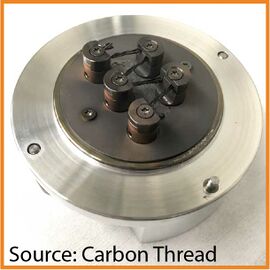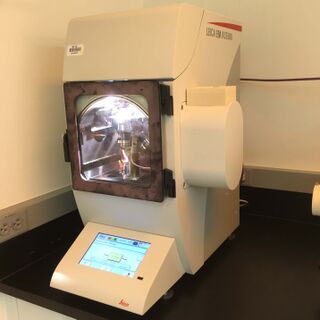Carbon Evaporator
|
Description
For non-conductive specimens that cannot be effectively SEM- or FIB-imaged with some combination of low voltage, low current, zero detector bias, and scanning filters, depositing a thin conductive layer of carbon on the surface can improve imaging. This carbon evaporator produces high-quality amorphous films with thicknesses ranging from sub-nm to 10 nm, with a morphology that is generally undetectable in electron microscopes. After imaging, the carbon layer can be gently removed using an O2 plasma, for example, with the lab's Tergeo Plus Plasma Cleaner. The is also equipped with a metal sputtering capability (e.g., Au), which produces a fine-grained metallic layer and expands its range of applications.
Applications
- Coat a material surface to make a sample conductive for SEM or FIB imaging.
- Coat resist surface to make a ample conductive for e-beam lithography.
- Apply carbon to a specimen or device for other fabrication purposes.
Possible Target Materials & Deposition Methods
- Carbon — via evaporation
- Metal (e.g., Au, Pt, Cr, W) — via sputtering
Resources
Equipment Data

SOP & Troubleshooting
- SOP & Troubleshooting Guide
- The procedure to install a new carbon thread can be found on Page 39 of the Operating Manual
- Note: always install as a "double thread," i.e. double the thread back over itself before installing – a thread length that is approximately twice the length of the evaporator's door width is long enough to double over and install.
Video
Technical Notes
Manufacturer Manual
Specifications
Manufacturer Specifications
Carbon Evaporation Specifications
- Average Deposition Rate: ~1 nm per pulse, when using a double thread (i.e. a thread that is doubled over on itself; see notes in SOP section above)
- Monitor deposition thickness using the quartz crystal thickness monitor, or simply program the number of pulses that you want
Related Instrumentation in the KNI
Sample Preparation for Microscopy
- Oxygen & Argon Plasma Cleaner (Tergeo Plus ICP- & CCP-RIE) to remove hydrocarbons from surface
- Carbon Evaporator (Leica EM ACE600) to make samples conductive
- TEM Sample Preparation Equipment: Polishing Stations, 3 mm Disk Cutter, Dimpler, Argon Ion Mill
